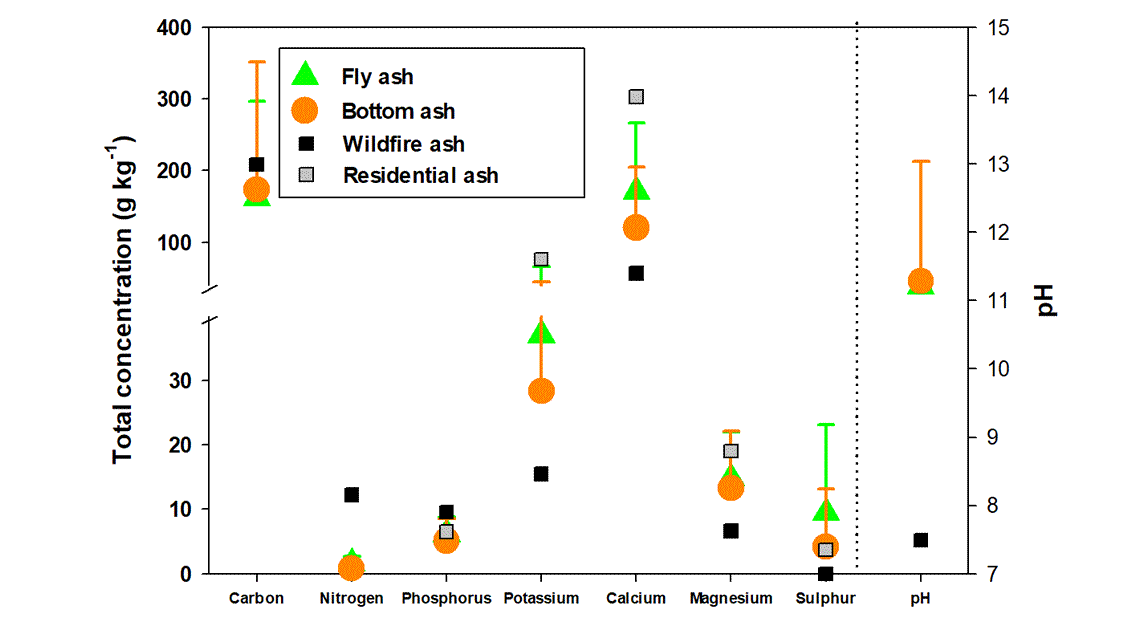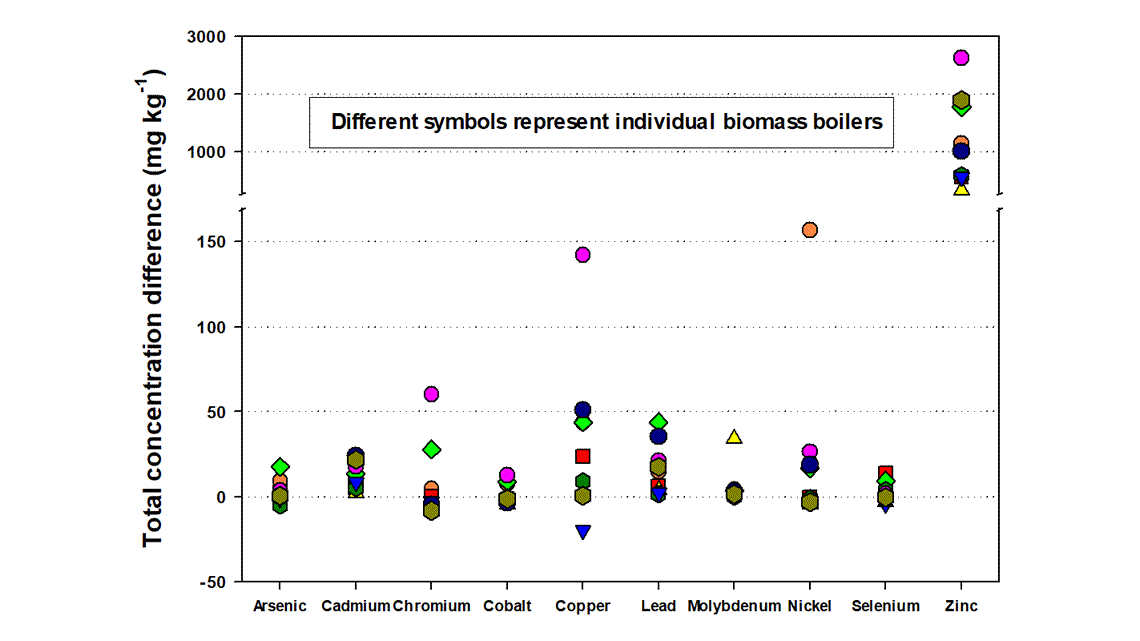Canadian Wood Ash Chemistry Database
The Canadian Wood Ash Chemistry database contains information on the chemical composition of wood ashes sampled from 21 Canadian biomass boilers: 10 pulp and paper mills and 11 bioenergy co-generation facilities. At nine of these facilities, separate samples of bottom and fly ash were collected for analysis.
The goal of the Canadian Wood Ash Chemistry database is to provide information about the levels and variation in the element concentrations of fly and bottom ashes formed during the combustion of woody biomass, and how they compare with the trace element limits established by the Canadian Council of Ministers of the Environment (CCME).
Graphs and tables
- pH, carbon and nutrient concentrations of Canadian fly and bottom wood ashes
- Trace element concentrations of Canadian fly and bottom wood ashes for arsenic, cadmium molybdenum and selenium
- Trace element concentrations of Canadian fly and bottom wood ashes for chromium, cobalt, copper, lead, nickel and zinc
- Differences in trace element concentrations between paired fly ash and bottom wood ash
The data below summarizes the chemistries of 19 bottom ash samples and 12 fly ash samples. Each figure also includes values for an ash sample collected from a wildfire that happened in July 2017, in Kaleden, British Columbia and the mean of 13 residential wood stove ashes collected during the winter of 2016 to 2017, from the Muskoka region of Ontario.
If you have wood ash chemistry data that you can contribute to this database, or ash samples that we could analyze to add new data, please contact Caroline Emilson, Doreen Churchill or Jérôme Laganière.
pH, carbon and nutrient concentrations of Canadian fly and bottom wood ashes

Figure 1. pH, carbon and nutrient concentrations of Canadian fly and bottom wood ashes, along with a reference point for concentrations from 1 wildfire ash and 13 residential wood stove ash samples, in grams per kilogram (g kg-1). Data represent mean and standard deviation.
Graph summary
Across ash types, nitrogen, sulphur and phosphorus concentrations were generally lower in comparison to magnesium, potassium and calcium. Mean nutrient concentrations of fly ash were greater than bottom ash. When compared to fly and bottom ash, wildfire ash tended to have a greater concentration of nitrogen and phosphorus, a lower pH, a lower concentration of potassium, calcium, magnesium and sulphur. Residential ash has a greater concentration of potassium and calcium when compared to fly and bottom ash.
Graph data
| pH, carbon and nutrients | Fly ash | Bottom ash | Wildfire ash | Residential ash |
|---|---|---|---|---|
| pH in H2O | 11.2 (8.1 – 13.8) | 11.3 (7.5 – 12.5) | 12.2 | - |
| Total C (g kg-1) | 162.3 (27.3 – 429.9) | 173.6 (5.0 – 517.7) | 208.3 | - |
| Total N (g kg-1) | 1.62 (0.40 – 3.84) | 0.82 (<0.01 – 2.63) | 12.3 | - |
| Total P (g kg-1) | 6.1 (1.9 – 10.6) | 5.1 (0.1 – 11.9) | 9.6 | 6.5 (5.5 – 7.8) |
| Total K (g kg-1) | 37.0 (11.7 – 96.6) | 28.3 (0.8 – 71.8) | 15.5 | 76.6 (60.6 – 97.7) |
| Total Ca (g kg-1) | 170.8 (47.7 – 402.5) | 120.7 (3.9 – 327.5) | 56.5 | 303.0 (260.0 – 380.0) |
| Total Mg (g kg-1) | 14.8 (6.4 – 29.4) | 13.3 (0.6 – 33.1) | 6.6 | 19.0 (15.1 – 40.9) |
| Total S (g kg-1) | 13.8 (0.0 – 42.2) | 4.2 (0.0 – 33.5) | 0.0 | 3.7 (1.9 – 4.9) |
Trace element concentrations of Canadian fly and bottom wood ashes for arsenic, cadmium molybdenum and selenium

Figure 2. Trace element concentrations of Canadian fly and bottom wood ashes, along with a reference point for concentrations from 1 wildfire ash and 13 residential wood stove ash samples, in milligrams per kilogram (mg kg-1). Data represents mean and standard deviation.
Graph summary
Mean concentrations of arsenic, cadmium, molybdenum and selenium for fly and bottom ash were generally greater than Category A Compost limits, but less than Category B Compost limits. Wood ash with these levels of trace elements is classified as “restricted”. This ash could be used for land application, but would be required to follow provincial and territorial regulations.
Concentrations of wildfire and residential ash tended to be less than fly or bottom ash concentrations for arsenic and selenium.
Guidance documents outlining regulations are listed in Regulations and guidelines for the use of wood ash as a soil amendment in Canadian forests. Information Report GLC-X- 17 (2016).
Graph data
| Trace element | Fly ash | Bottom ash | Wildfire ash | Residential ash | Category A Compost | Category B Compost |
|---|---|---|---|---|---|---|
| Arsenic (mg kg-1) | 10.3 (0.6 – 27.9) | 17.3 (<0.1 – 139.0) | 2.7 | 0.7 (0.2 – 2.5) | 13 | 75 |
| Cadmium (mg kg-1) | 11.1 (2.3 – 24.6) | 2.6 (0.1 – 8.3) | 3.7 | 2.1 (0.3 – 5.6) | 3 | 20 |
| Molybdenum (mg kg-1) | 7.5 (2.9 – 36.9) | 3.1 (0.2 – 6.2) | 7.1 | 2.8 (1.0 – 5.0) | 5 | 20 |
| Selenium (mg kg-1) | 7.0 (0.7 – 20.0) | 5.1 (<0.1 – 24.2) | 1.9 | 0.2 (0.2 – 0.4) | 2 | 14 |
Notes
Category A Compost: Wood ash with trace element concentrations that fall below the limits set for Category A compost by the CCME is considered “unrestricted” and can be used as a soil amendment in any application.
Category B Compost: Wood ash with trace element concentrations that fall above CCME limits for Category A Compost but below the limits for Category B Compost has “restricted” use and “may require additional control when deemed necessary by a province or territory”. Wood ash with trace element concentrations above the limits for Category B Compost “must be used or disposed of appropriately”.
Trace element concentrations of Canadian fly and bottom wood ashes for chromium, cobalt, copper, lead, nickel and zinc

Figure 3. Trace element concentrations of Canadian fly and bottom wood ashes, along with a reference point for concentrations from 1 wildfire ash and 13 residential wood stove ash samples, in milligrams per kilogram (mg kg-1). Data represents mean and standard deviation.
Graph summary
Mean concentrations of chromium, cobalt, copper, lead and nickel in fly, bottom, wildfire and residential ash were all less than Category A Compost limits. Wood ash with these levels of trace elements is classified as “unrestricted” and can be used in any land application.
Mean zinc concentrations in fly ash were greater than Category A Compost limits placing these ashes in the “restricted” category. This ash could be used for land application but would be required to follow provincial and territorial specific regulations.
Guidance documents outlining regulations are listed in Regulations and guidelines for the use of wood ash as a soil amendment in Canadian forests. Information Report GLC-X- 17 (2016).
Graph data
| Trace element | Fly ash | Bottom ash | Wildfire ash | Residential ash | Category A Compost | Category B Compost |
|---|---|---|---|---|---|---|
| Chromium (mg kg-1) | 32.9 (15.0 – 67.9) | 44.9 (7.8 – 182.0) | 62.3 | 6.4 (0.6 – 42) | 210 | 1060 |
| Cobalt (mg kg-1) | 10.3 (4.8 – 20.1) | 9.5 (0.1 – 15.6) | 8.4 | 1.4 (0.5 – 4.2) | 34 | 150 |
| Copper (mg kg-1) | 80.8 (35.0 – 144.6) | 61.0 (<0.1 – 205.0) | 31.6 | 110.5 (76.0 – 212.0 | 400 | 757 |
| Lead (mg kg-1) | 21.1 (3.3 – 61.3) | 47.5 (0.5 – 369.0) | 24.5 | 6.1 (1.5 – 38.5) | 150 | 500 |
| Mercury (mg kg-1) | n/a | n/a | n/a | n/a | 0.8 | 5 |
| Nickel (mg kg-1) | 36.5 (10.3 – 184.4) | 30.2 (3.3 – 153.3) | 19.8 | 4.4 (0.3 – 9.2) | 62 | 180 |
| Zinc (mg kg-1) | 1167.5 (250.2 – 2661.5) | 411.6 (32.1 – 1504.0) | 205 | 536.0 (264.0 – 720.0) | 700 | 1850 |
Notes
Category A Compost: Wood ash with trace element concentrations that fall below the limits set for Category A compost by the CCME is considered “unrestricted” and can be used as a soil amendment in any application.
Category B Compost: Wood ash with trace element concentrations that fall above CCME limits for Category A Compost but below the limits for Category B Compost has “restricted” use and “may require additional control when deemed necessary by a province or territory”. Wood ash with trace element concentrations above the limits for Category B Compost “must be used or disposed of appropriately”.
CCME trace element limits in milligrams per kilogram (mg kg-1). These limits were originally developed for compost. Trace element limits for chromium and copper were not established but would be 1060 mg kg-1 and 757 mg kg-1, respectively, if calculated with the same method used to establish limits for the other nine trace elements (Canadian Council of Ministers of the Environment 2005 [920.3 Kb PDF]).
Differences in trace element concentrations between paired fly ash and bottom wood ash

Figure 4. Differences in trace element concentrations between paired fly ash and bottom wood ash sampled from nine Canadian biomass boilers. (Different symbols represent individual biomass boilers)
Graph summary
Trace element concentrations in fly ash were predominately greater than trace element concentrations in bottom ash for samples from the same biomass boiler. Zinc concentrations differed the most between fly ash and bottom ash. Cobalt and nickel were exceptions, with higher concentrations in bottom ash at six and five of the nine boilers respectively.
Graph data
| Boiler #1 | Boiler #2 | Boiler #3 | Boiler #4 | Boiler #5 | Boiler #6 | Boiler #7 | Boiler #8 | Boiler #9 | |
|---|---|---|---|---|---|---|---|---|---|
| Arsenic | 9.0338 | 3.0292 | 17.5794 | 0.1843 | -5.3172 | -0.7628 | 3.5364 | 0.1846 | 0.4554 |
| Cadmium | 8.3431 | 5.1443 | 13.4973 | 1.9982 | 5.1276 | 8.3074 | 17.6696 | 24.0259 | 21.6561 |
| Chromium | 4.3652 | 0.3292 | 27.6719 | -6.503 | -4.7022 | -3.0197 | 60.1079 | -4.9132 | -8.2243 |
| Cobalt | 7.9241 | -1.3959 | 8.9762 | -4.7974 | -0.4784 | -1.8794 | 12.3809 | -3.5512 | -1.1978 |
| Copper | 43.7913 | 23.6275 | 43.7123 | 0.8982 | 9.1122 | -19.8927 | 142.2584 | 50.9435 | 0.6402 |
| Lead | 14.9886 | 5.9771 | 43.6978 | 3.8695 | 1.4917 | 2.134 | 21.0371 | 35.3676 | 17.6405 |
| Molybdenum | 2.0742 | 1.6636 | 3.4668 | 33.8473 | -0.0759 | 1.0197 | 3.8438 | 3.2326 | 1.6314 |
| Nickel | 156.5232 | -0.4009 | 16.6552 | -4.5393 | -1.0324 | -3.0928 | 26.3957 | 18.4744 | -3.1198 |
| Selenium | -1.8575 | 13.8838 | 9.4604 | -2.9942 | 4.1309 | -4.2297 | 1.5112 | -1.1171 | -0.214 |
| Zinc | 1137.6927 | 561.2883 | 1777.5209 | 337.1577 | 598.3535 | 565.9733 | 2629.3787 | 1008.759 | 1894.216 |
Notes
Data represent calculated differences between fly ash and bottom ash trace element concentrations for individual boilers. Values that are greater than zero indicate that trace elements were more concentrated in fly ash; values that are less than zero indicate that trace elements were more concentrated in bottom ash.
Sources and information
- Azan, S.S.E; Yan, N.D.; et al. 2019. Could a residential wood ash recycling programme be part of the solution to calcium decline in lakes and forests in Muskoka (Ontario, Canada)? FACETS 4 (1)
- Hannam, K.D.; Deschamps, C.; et al. 2016. Regulations and guidelines for the use of wood ash as a soil amendment in Canadian forests. Information Report GLC-X- 17.
Page details
- Date modified: